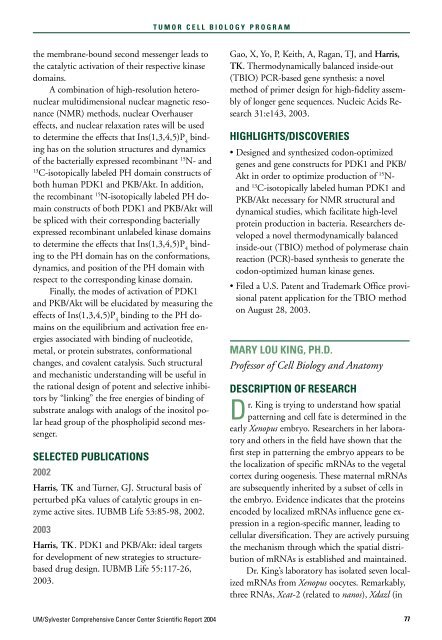SCIENTIFIC REPORT 2004 - Sylvester Comprehensive Cancer Center
SCIENTIFIC REPORT 2004 - Sylvester Comprehensive Cancer Center
SCIENTIFIC REPORT 2004 - Sylvester Comprehensive Cancer Center
You also want an ePaper? Increase the reach of your titles
YUMPU automatically turns print PDFs into web optimized ePapers that Google loves.
T U M O R C E L L B I O L O G Y P R O G R A M<br />
the membrane-bound second messenger leads to<br />
the catalytic activation of their respective kinase<br />
domains.<br />
A combination of high-resolution heteronuclear<br />
multidimensional nuclear magnetic resonance<br />
(NMR) methods, nuclear Overhauser<br />
effects, and nuclear relaxation rates will be used<br />
to determine the effects that Ins(1,3,4,5)P 4<br />
binding<br />
has on the solution structures and dynamics<br />
of the bacterially expressed recombinant 15 N- and<br />
13<br />
C-isotopically labeled PH domain constructs of<br />
both human PDK1 and PKB/Akt. In addition,<br />
the recombinant 15 N-isotopically labeled PH domain<br />
constructs of both PDK1 and PKB/Akt will<br />
be spliced with their corresponding bacterially<br />
expressed recombinant unlabeled kinase domains<br />
to determine the effects that Ins(1,3,4,5)P 4<br />
binding<br />
to the PH domain has on the conformations,<br />
dynamics, and position of the PH domain with<br />
respect to the corresponding kinase domain.<br />
Finally, the modes of activation of PDK1<br />
and PKB/Akt will be elucidated by measuring the<br />
effects of Ins(1,3,4,5)P 4<br />
binding to the PH domains<br />
on the equilibrium and activation free energies<br />
associated with binding of nucleotide,<br />
metal, or protein substrates, conformational<br />
changes, and covalent catalysis. Such structural<br />
and mechanistic understanding will be useful in<br />
the rational design of potent and selective inhibitors<br />
by “linking” the free energies of binding of<br />
substrate analogs with analogs of the inositol polar<br />
head group of the phospholipid second messenger.<br />
SELECTED PUBLICATIONS<br />
2002<br />
Harris, TK and Turner, GJ. Structural basis of<br />
perturbed pKa values of catalytic groups in enzyme<br />
active sites. IUBMB Life 53:85-98, 2002.<br />
2003<br />
Harris, TK . PDK1 and PKB/Akt: ideal targets<br />
for development of new strategies to structurebased<br />
drug design. IUBMB Life 55:117-26,<br />
2003.<br />
Gao, X, Yo, P, Keith, A, Ragan, TJ, and Harris,<br />
TK. Thermodynamically balanced inside-out<br />
(TBIO) PCR-based gene synthesis: a novel<br />
method of primer design for high-fidelity assembly<br />
of longer gene sequences. Nucleic Acids Research<br />
31:e143, 2003.<br />
HIGHLIGHTS/DISCOVERIES<br />
• Designed and synthesized codon-optimized<br />
genes and gene constructs for PDK1 and PKB/<br />
Akt in order to optimize production of 15 N-<br />
and 13 C-isotopically labeled human PDK1 and<br />
PKB/Akt necessary for NMR structural and<br />
dynamical studies, which facilitate high-level<br />
protein production in bacteria. Researchers developed<br />
a novel thermodynamically balanced<br />
inside-out (TBIO) method of polymerase chain<br />
reaction (PCR)-based synthesis to generate the<br />
codon-optimized human kinase genes.<br />
• Filed a U.S. Patent and Trademark Office provisional<br />
patent application for the TBIO method<br />
on August 28, 2003.<br />
MARY LOU KING, PH.D.<br />
Professor of Cell Biology and Anatomy<br />
DESCRIPTION OF RESEARCH<br />
Dr. King is trying to understand how spatial<br />
patterning and cell fate is determined in the<br />
early Xenopus embryo. Researchers in her laboratory<br />
and others in the field have shown that the<br />
first step in patterning the embryo appears to be<br />
the localization of specific mRNAs to the vegetal<br />
cortex during oogenesis. These maternal mRNAs<br />
are subsequently inherited by a subset of cells in<br />
the embryo. Evidence indicates that the proteins<br />
encoded by localized mRNAs influence gene expression<br />
in a region-specific manner, leading to<br />
cellular diversification. They are actively pursuing<br />
the mechanism through which the spatial distribution<br />
of mRNAs is established and maintained.<br />
Dr. King’s laboratory has isolated seven localized<br />
mRNAs from Xenopus oocytes. Remarkably,<br />
three RNAs, Xcat-2 (related to nanos), Xdazl (in<br />
UM/<strong>Sylvester</strong> <strong>Comprehensive</strong> <strong>Cancer</strong> <strong>Center</strong> Scientific Report <strong>2004</strong> 77
















